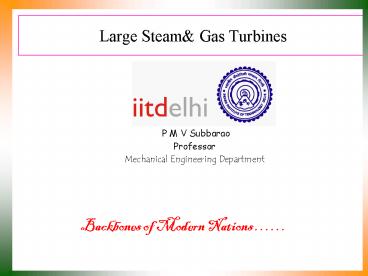Large Steam - PowerPoint PPT Presentation
1 / 26
Title:
Large Steam
Description:
Title: Natural Cycle of Universe Author: P.M.V.S Last modified by: hp Created Date: 1/11/2002 2:48:10 AM Document presentation format: On-screen Show (4:3) – PowerPoint PPT presentation
Number of Views:87
Avg rating:3.0/5.0
Title: Large Steam
1
Large Steam Gas Turbines
- P M V Subbarao
- Professor
- Mechanical Engineering Department
Backbones of Modern Nations
2
Advanced 700 8C Pulverised Coal-fired Power Plant
Project
3
The state-of-the-art Gas Turbines
- The newer large industrial gas turbines size have
increased and capable of generating as much as
200 MW at 50 Hz. - The turbine entry temperature has increased to
12600C, and the pressure ratio is 161. - Typical simple cycle efficiencies on natural gas
are 35. - The ABB GT 13 E2 is rated at 164 MW gross output
on natural gas, with an efficiency of 35.7. - The pressure ratio is 151.
- The combustion system is designed for low Nox
production. - The dry Nox is less than 25 ppm on natural gas.
- The turbine entry temperature is 11000C and the
exhaust temperature is 5250C. - The turbine has five stages, and the first two
rotor stages and the first three stator stages
are cooled - the roots of the last two stages are also cooled.
4
(No Transcript)
5
9756 kJ/kWh
6
Stage with General Value of Degree of Reaction
Total possible drop in Enthalpy
Exact definition of DoR
7
Theory of General Reaction Blading
Vr2 gt Vr1
Ideal reaction blade
8
Available power in L Reaction stage
9
Stage Sizing
10
Selection of Degree of Reaction
11
Definition of Isentropic/adiabatic Efficiency
- Relative blade efficiency is calculated as
- Internal Relative Efficiency is calculated as
12
Typical Distribution of Losses AStages
13
Structure of Large HP Turbine
14
Calculations of HP and IP Turbine Efficiencies
- The efficiency of a joined group of turbine
stages between two successive bleed points is
defined. - Full loss of the exit velocity in the last stage,
for operation on superheated steam is also
accounted. - The statistically generalized expression is
15
where
Z No. of stages in group,
a1 Nozzle exit angle
16
Calculations of Last LP Last Stage Turbine
Efficiency
- To calculate the internal relative efficiency for
the low pressure cylinder, proper consideration
to be given to incorporate losses due to exit
velocity and the losses due to moisture. - The statistically generalized expression is
17
Axial surface area at the exit from last stage
moving blades, and
Average diameter to blade height ratio is
i No. of flows in LP turbine
18
General Rules for Steam Path Design
- For HP Axial (flow) velocity at the inlet is 40
m/sec and at the outlet 65 m/sec. - For IP axial velocity of steam at the inlet is
60 m/sec and at the outlet 80 m/sec - For LP axial velocity of steam at the inlet is
75 m/sec and at the outlet of last front stage is
130 m/sec. - Maximum mean blade speed used so far 450 m/s
- Generally acceptable range of inlet flow
angle(a1) 150 to 200
19
Stage Loading and Flow Coefficient
Stage Loading Coefficient Ratio of specific
stage work output and square of mean rotor speed.
Flow Coefficient Ratio of the axial velocity
entering to the mean rotor speed.
20
Regions of Design
y
Fflow
21
General Rules for Efficient Economic Flow Path
Design
- For HP Axial (flow) velocity at the inlet is 40
m/sec and at the outlet 65 m/sec. - For IP axial velocity of steam at the inlet is
60 m/sec and at the outlet 80 m/sec - For LP axial velocity of steam at the inlet is
75 m/sec and at the outlet of last front stage is
130 m/sec. - Maximum mean blade speed used so far 450 m/s
- Generally acceptable range of inlet flow
angle(a1) 150 to 200
22
y
F
23
Range of turbine Design Parameter
- High Pressure Turbine
- Maximum AN2 2.5107 3.3 107 m2.rpm2.
- Stage loading coefficient 1.4 2.0
- Stage Exit Mach Number 0.4 0.5
- Low Pressure Turbine
- Inlet mass flow rate 195 215 kg/m2.s
- Hub/tip ratio .35-.5
- Max. Stage loading (based on hub) 2.4
- Exit Mach Number 0.4 0.5
24
With known value of U , change enthalpy is
obtained .
For reaction turbine maximum efficiency occurs at
certain loading factor
From change in enthalpy absolute velocity of
steam can be obtained
25
Enthalpy Entropy Diagram for Multistage Turbine
Turbine Inlet
Stage 1
h
Stage 2
Stage 3
Stage 4
Stage 5
Turbine Exit
s
26
Optimal Variable Reaction 3D Blade Designs































